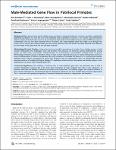Male-mediated gene flow in patrilocal primates.
Schubert, Grit
Stoneking, Colin J.
Arandjelovic, Mimi
Boesch, Christophe
Eckhardt, Nadin
Hohmann, Gottfried
Langergraber, Kevin
Lukas, Dieter
Vigilant, Linda
Background: Many group–living species display strong sex biases in dispersal tendencies. However, gene flow mediated by apparently philopatric sex may still occur and potentially alters population structure. In our closest living evolutionary relatives, dispersal of adult males seems to be precluded by high levels of territoriality between males of different groups in chimpanzees, and has only been observed once in bonobos. Still, male–mediated gene flow might occur through rare events such as extra–group matings leading to extra–group paternity (EGP) and female secondary dispersal with offspring, but the extent of this gene flow has not yet been assessed. Methodology/Principal Findings: Using autosomal microsatellite genotyping of samples from multiple groups of wild western chimpanzees (Pan troglodytes verus) and bonobos (Pan paniscus), we found low genetic differentiation among groups for both males and females. Characterization of Y–chromosome microsatellites revealed levels of genetic differentiation between groups in bonobos almost as high as those reported previously in eastern chimpanzees, but lower levels of differentiation in western chimpanzees. By using simulations to evaluate the patterns of Y–chromosomal variation expected under realistic assumptions of group size, mutation rate and reproductive skew, we demonstrate that the observed presence of multiple and highly divergent Y–haplotypes within western chimpanzee and bonobo groups is best explained by successful male–mediated gene flow. Conclusions/Significance: The similarity of inferred rates of male–mediated gene flow and published rates of EGP in western chimpanzees suggests this is the most likely mechanism of male–mediated gene flow in this subspecies. In bonobos more data are needed to refine the estimated rate of gene flow. Our findings suggest that dispersal patterns in these closely related species, and particularly for the chimpanzee subspecies, are more variable than previously appreciated. This is consistent with growing recognition of extensive behavioral variation in chimpanzees and bonobos.
Dateien zu dieser Publikation
Keine Lizenzangabe
Verwandte Publikationen
Anzeige der Publikationen mit ähnlichem Titel, Autor, Urheber und Thema.
-
2007-05-25ZeitschriftenartikelFepA- and TonB-dependent bacteriophage H8: receptor binding and genomic sequence. Rabsch, Wolfgang; Ma, Li; Wiley, Graham; Najar, Fares Z.; Kaserer, Wallace; Schuerch, Daniel W.; Klebba, Joseph E.; Roe, Bruce A.; Gomez, Jenny A. Laverde; Schallmey, Marcus; Newton, Salete M. C.; Klebba, Phillip E.H8 is derived from a collection of Salmonella enterica serotype Enteritidis bacteriophage. Its morphology and genomic structure closely resemble those of bacteriophage T5 in the family Siphoviridae. H8 infected S. enterica ...
-
2005-06-20ZeitschriftenartikelViral promoters can initiate expression of toxin genes introduced into Escherichia coli Lewin, Astrid; Mayer, Martin; Chusainow, Janet; Jacob, Daniela; Appel, BerndBackground: The expression of recombinant proteins in eukaryotic cells requires the fusion of the coding region to a promoter functional in the eukaryotic cell line. Viral promoters are very often used for this purpose. ...
-
2013-08-08ZeitschriftenartikelCytomegalovirus Downregulates IRE1 to Repress the Unfolded Protein Response Stahl, Sebastian; Burkhart, Julia M.; Hinte, Florian; Tirosh, Boaz; Mohr, Hermine; Zahedi, René P.; Sickmann, Albert; Ruzsics, Zsolt; Budt, Matthias; Brune, WolframDuring viral infection, a massive demand for viral glycoproteins can overwhelm the capacity of the protein folding and quality control machinery, leading to an accumulation of unfolded proteins in the endoplasmic reticulum ...

